Of the more than 100 million homes in the United States, however, only one percent are conducive to aging in place, reports Rodney Harrell, AARP’s in-house housing expert, in a recent Forbes article. That’s because aging in place successfully means looking at your home environment as it is today and reshaping it so that it remains safe, comfortable, and accessible through every stage of the aging process. And while it’s easy to look at some rooms—kitchens and bathrooms, for example—and see the challenges they’ll present in later years, it’s also easy to overlook one of the most important rooms in the house.
Only one percent of homes are conducive to aging in place.
Because it’s associated with rest and comfort, planning ahead to avoid hazards in the bedroom may come in low on your list of priorities. But you do a lot of living in the bedroom: you spend your sleeping hours there, and you will very likely spend much of your waking time there getting ready for the day and the day’s end. You’ll have to navigate your bedroom in the dark, and you may have to navigate it when you’re ill or injured. If you have the misfortune to become bedridden, you may spend entire days in the bedroom. To age in place successfully, you need to plan ahead for a safe, comfortable bedroom as you would for any room in your house.
Here are a few suggestions to get you started.
When a Bedroom on the First Floor Isn’t an Option
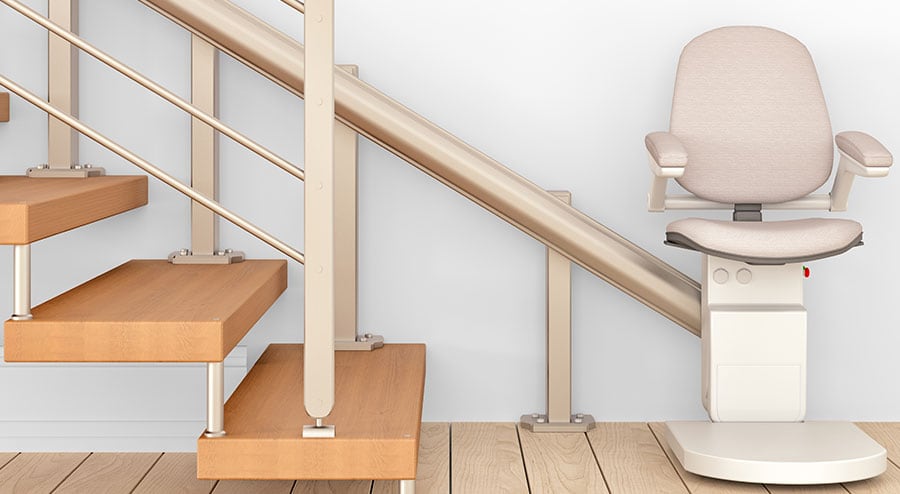
Almost seven million Americans, many of them seniors, use some type of assistance device for mobility. This may be a cane, a walker, a motorized scooter, a wheelchair, or crutches. For these individuals, stairs and multi-story homes present a serious challenge. Even if you currently require no assistance walking or maneuvering up and down stairs, your aging-in-place plan should include a bedroom on the first or main floor.
Stair lifts benefit people dealing with a wide range of issues, including problems with balance, knee and back problems, heart and lung issues, and other types of mobility challenges.
A ground-floor bedroom may not be an option for you, however. In that case, you may want to consider a home stair lift. Stair lifts benefit people dealing with a wide range of issues, including problems with balance, knee and back problems, heart and lung issues, and other types of mobility challenges. Different types of stair lift designs may offer better comfort and ease of use, depending on the challenges you’re dealing with. For example, a standing platform can be more beneficial for someone with problems bending their knees, and yet it’s not as wide as a full-seated lift, which features a seat and footrest, and typically is operated by the push of a button. You might also opt for a lift that has a perch-style seat, as this doesn’t require a full bend and is also good for those with knee problems.
Other stair lifts offer a sit/stand choice, popular for multi-person homes and for seniors with declining mobility. Additional features to consider are swivel options, the rail shape (how it fits in your stairway), adjustability, and remote control functions. For a comprehensive listing of home stair lifts, visit Consumer Affairs.
Bedroom Safety
Once you’ve planned for a ground-floor bedroom or mastered the accessibility challenges of a bedroom elsewhere, it’s time to focus on the bedroom itself. Because you spend so much time in the bedroom, it’s essential to plan with safety as a number one priority.
Because you spend so much time in the bedroom, it’s essential to plan with safety as a number one priority.
“Falls are the leading cause of unintentional injury among adults age 65 and older,” reports the U.S. National Library of Medicine (NLM). For this reason, a safer, well-maintained bedroom can help you maintain your independence longer and decrease the risk for life-threatening accidents. Declutter spaces and clear walkways for easy movement. Remove all area or throw rugs: health experts warn that any type of loose rug or unsecured carpet is an environmental hazard that puts seniors at risk for falls and their related injuries. In addition to removing the throw rugs, be sure to check the room’s carpeting. If it is damaged and has any ragged or curled up edges, it can pose a trip risk, too.
As you work, consider the following questions:
- Is there a clear and easy path to the doorway and/or the adjoining bathroom?
- Do all windows have secure screens and locks? This is especially important for main floor bedrooms.
- Are window fittings easily used by people with arthritis, and those with visual impairments?
- Is all the furniture sturdy, without any chance of tip-overs?
- Are items used daily within easy reach?
- Are electronics and medical equipment properly secured and placed with cords and cables out of the way?
If you keep medical equipment in your room, make sure to follow all home care instructions for storage, and especially follow all safety protocols for medical oxygen, like keeping the cylinder at least five feet away from all heat sources.
Bed Enhancements and Upgrades
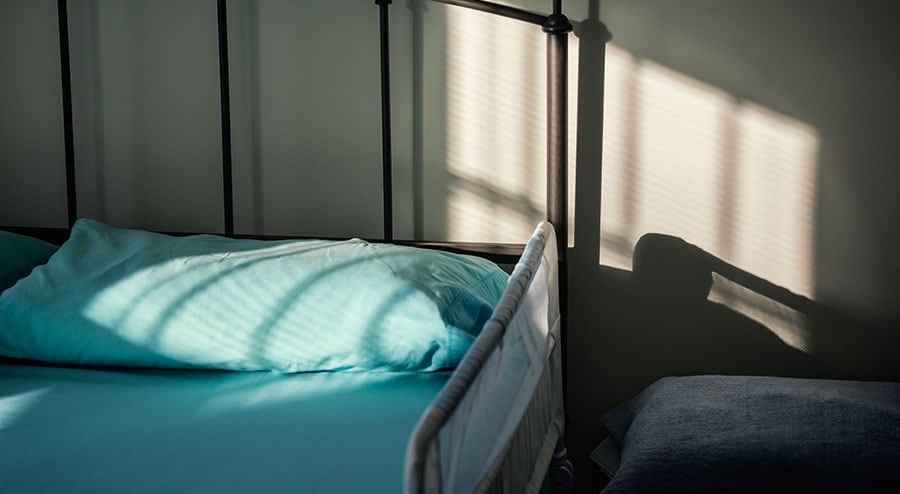
At the heart of the bedroom is one essential piece of furniture, the bed. Again, aging in place requires planning ahead, so as you think about your bed, keep in mind that sleep patterns often change with aging and many older people find it more difficult to fall asleep and stay asleep.
Avoid bed skirting or any type of bedspread, comforter, or duvet that reaches all the way to the floor. Feet can get tangled in these types of bedclothes, and a fall can result.
For this reason, the bedroom remodel may be the perfect time to replace an older bed and upgrade to one that will be better suited for aging in place. While a hospital bed can provide certain benefits (including the ability to be raised and lowered as needed), you should consider the alternatives, too. An adjustable bed, for example, looks like a standard bed when it’s flat, but it allows you to raise and lower both the head and the foot to obtain your most comfortable, customized sleep position. Some adjustable beds come with massage features, wireless hand controls, and the ability to adjust the firmness of the mattress, too.
If your current bed serves its purpose, however, offering comfort and a good night’s sleep, it may not be necessary to replace it. You may simply want to upgrade it instead. A fall mat can be placed on the floor at the side of the bed for additional protection, if needed. An under-the-bed light that’s triggered by a motion sensor can offer much-needed illumination as soon as you step out of bed.
More importantly, installing bed rails can provide both safety and peace of mind. You can find bed or side rails in a variety of styles, including ones that adjust for height and length. As you consider this option, remember:
- Not all bed rails are designed to be operated (raised/lowered) by the person in the bed. Some require a caregiver’s help.
- A safety bed rail keeps you from rolling and falling out of the bed.
- An assist rail is designed to offer stability and balance when you need to get in and out of the bed; a floor-to-ceiling safety pole can serve the same function.
- Bumper pads that fit over the bed rails add a soft, cushioned surface.
- Not all beds can be fitted with rails. These include waterbeds, platform-style beds, and certain Sleep Number beds.
Finally, remember that you may want to invest in new bedding as part of the bedroom remodel and upgrade. If you do look for new bedding, avoid bed skirting or any type of bedspread, comforter, or duvet that reaches all the way to the floor. Feet can get tangled in these types of bedclothes, and a fall can result. Note, too, that a hospital bed will require special sizes of sheets, so those are a must if that’s the type of bed you select. Consider mattress protectors as well: they help prevent odor or wetness issues with your mattress and can be laundered regularly to stay fresh and clean.
One final note: while considering whether or not to keep your old bed—and as you look at models to get a new one—always remember that, to be safest, a bed should sit no more than 20- to 23-inches from the floor to the top of the mattress.
Sturdy Furniture
As you plan to age in place, you should give some thought to your other bedroom furnishings, because they can raise safety concerns as well. The last thing you want, for example, is for a bookcase to topple over when you reach out for balance. To avoid these kinds of accidents, make sure that all bedroom furniture is sturdy and secure. Tall furnishings like bookshelves and wardrobes should be anchored to the wall (a carpenter might be needed to take this step). Nightstands also need to be sturdy; you don’t want your bedside table to shift out of place if you’re using it for support, or for it to slide on the floor if bumped. Consider placing non-skid pads under the feet of nightstands, your dressers and any other furniture in the room.
The last thing you want is for a bookcase to topple over when you reach out for balance.
Flooring
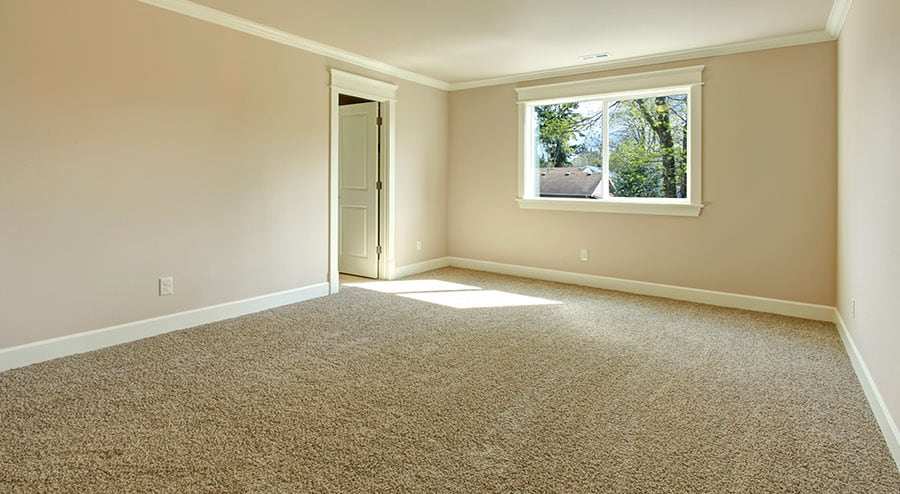
The best bedroom flooring is designed to minimize slipping and sliding by humans as well as by furniture. Good flooring also makes it easy to maneuver a wheelchair or motorized scooter or for a human to make their way with a walker or a cane. Your floor should also provide for easy upkeep and cleaning to allow the greatest independence possible while you age in place.
Your choice of flooring will depend on multiple factors, such as budget, décor preferences, your stage in the aging process, and any physical limitations or restrictions that you have. But here are some of the most popular options, and the pros and cons of each.
Good flooring makes it easy to maneuver a wheelchair or motorized scooter or for a human to make their way with a walker or a cane.
Hardwood floors are beautiful, but they can be damaged by moisture and any type of liquid spill. They can also, depending on their finish, create a falling hazard by making slips more likely. If you choose hardwood—or if you decide to keep the hardwood you already have—you can make it safer by adding safety strips that increase traction. And if you choose hardwood, either avoid using avoid area rugs or tape down their edges in order to minimize the risk of falling.
Laminate floors are an alternative to traditional hardwood flooring. If a wet spill on laminate flooring is wiped up before the liquid has a chance to seep in between the boards, the chance of damage is minimal, and beyond that, laminate flooring is easy to clean, resistant to stains, and maybe less expensive than hardwood to install. They can present similar safety issues as hardwood floors, however, so be sure to take the appropriate precautions.
Carpet can seem like an obvious solution, but it comes with its own set of challenges. Carpeting may make it difficult when using a walker, cane, or other mobility assistance device. Carpet fibers can also hold onto allergens, increasing the risk of respiratory issues for people who suffer from allergies.
Cork floors are a less-used option, but they are easy to clean and offer a softer surface in the event of a fall. Cork is naturally non-slip, which does help reduce the risk for falls and their related injuries. Unfortunately, cork is not water-friendly. It can be swept and vacuumed, but spills must be wiped and dried immediately to avoid damage, and mopping should be avoided.
Lighting
Bedroom lighting is a crucial element for anyone aging in place. The right lighting provides safety and health benefits, and can, of course, simply make the space more aesthetically pleasing. The Lighting Research Center (LRC) at the Rensselaer Polytechnic Institute has developed principles to guide older adults and their loved ones as they choose lighting for their homes. According to the LRC, someone choosing the lighting for the bedroom of an older adult should:
Consider touch-activated lamps, motion-activated lights, night lights, and toggle or rocker-style light switches that glow in the dark.
Increase Ambient and Task Light Levels
Ambient lighting is the general light provided by an overhead source, table lamp, or wall sconce. Task lighting is more concentrated and important for reading, applying makeup, and anything where you need to focus on something specific. Increasing the brightness of task lighting may require some additional lamps: for reading in bed, for example, one of the best options is a swing arm lamp mounted above the headboard or to the side, secured so the light hits just below eye level to help avoid eye strain. In terms of ambient light, one good idea is
Minimize Glare
Too-bright lights can be almost as bad as lights that are too dim. Make sure that there’s no chance that a reflected glare could temporarily blind or impair the vision of an older person coming into the room or turning on the lights.
Increase Contrast and Improve Color Perception
Eyesight in older adults changes. In addition to difficulties seeing distances or reading the newspaper, color perception also deteriorates. The experts at the LRC state that because color discrimination is more difficult for older adults, high illumination levels provided by high-quality fluorescent lamps (as opposed the traditional incandescent lights) can help older adults see and distinguish colors better. This is helpful when choosing clothing that matches and enjoying full-color reading material. Compact fluorescent lights also are cooler to the touch.
Balance Illumination Levels
If one part of the bedroom is too dim while the other is too bright, that can mean more problems with glare, or it can mean that older eyes that have adjusted to brighter lights may not adjust in time to navigate darker areas safely.
Other changes to consider for lighting in the bedroom are:
- Touch-activated bedside lamps
- Rocker-style light switches that are easier to work
- Toggle or rocker-style light switches that glow in the dark
- Lighter colored paint on the walls to minimize shadows
- Night lights (including the under-the-bed light mentioned earlier), especially ones responsive to motion.
Technology, Cords, and Cables
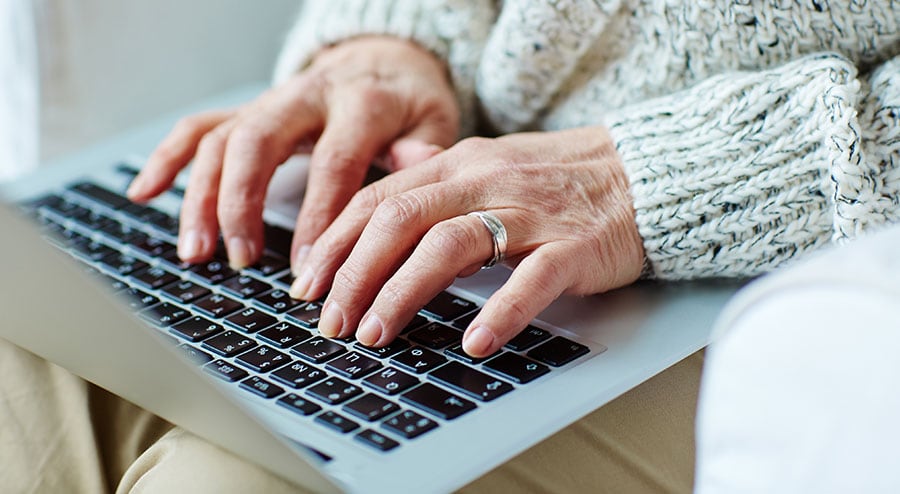
Electronics have become an essential part of daily living, but as you look to age in place, be aware that the cables that come with technology can turn into tripping hazards, so make sure all cords are kept out of high-traffic areas. As any type of frayed or damaged electrical cord is a fire hazard, act now to replace any that are older cables in the bedroom and in the house in general.
Today’s technology enables individuals to do so much more with more independence, and has the potential to make aging in place easier and safer.
It’s possible, too, to make cables less of an issue by giving some thought to where outlets should be located. If you’re having a full remodel done, talk to your electrician about placing electrical outlets in optimal locations around the room. That’s also an opportunity to set outlets at a more convenient height, since eliminating the need to stoop over and plug in a cord is helpful and important to anyone bound to a wheelchair, or with any type of mobility issue.
Make sure the room has Wi-Fi access if needed and that any charging stations for a phone, tablet, or other device are easy to reach and use. This isn’t just for the sake of convenience: today’s technology enables individuals to do so much more with more independence, and this has the potential to make aging in place easier and safer. Because every person and their needs are unique, it’s important to thoroughly research the many tech options available. AARP and CNET offer several recommendations for products and how to integrate them into the living space.
Phone Access
Communication is a must for any senior living at home and aging in place. The bedroom should have a working landline phone located next to the bed. This phone should be easy to handle with a keypad that’s backlit and large enough to read. A phone that allows for programmed numbers makes it easier to reach family, friends, and emergency assistance when needed. If the phone service is provided by a cable company, have a backup battery available in case of an outage; it’s also highly recommended that, despite the convenience of cordless phones, a corded phone be used on the bedside table. A power outage should not jeopardize a senior’s ability to communicate with the outside world.
Finally, reprogram all emergency and social numbers into all phones and update those numbers every three to six months as needed. Make paper copies of those numbers as well. Keep at least one copy in the nightstand drawer and one in a family member’s home in case the others are misplaced.
Closet(s)
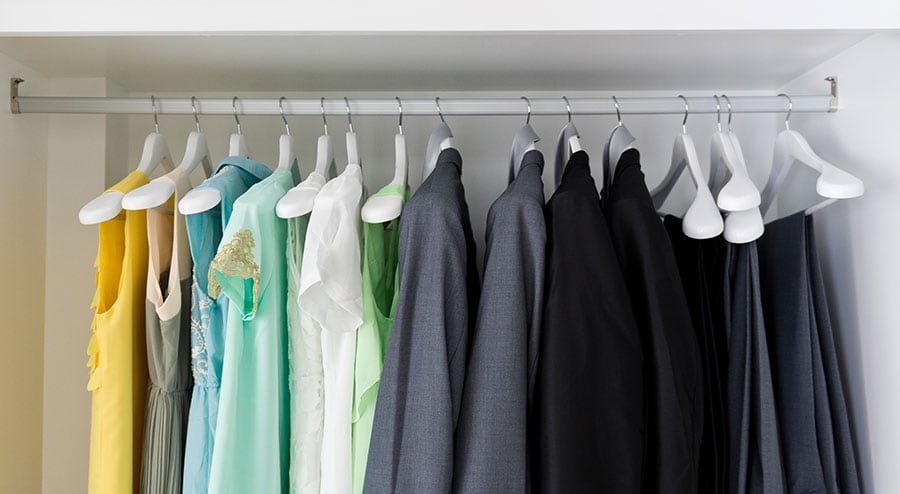
Creating a master bedroom for aging in place ideally includes a spacious and well-lit walk-in closet with storage that’s easy to reach. As you refit the closet, lower the shelves so items can be reached without struggle or the need to risk a tumble from a step stool. Make sure, too, that the doorway to the walk-in closet is wide enough to accommodate any type of mobility assistance device, and that there’s ample room to maneuver a wheelchair or other device inside.
Make sure that the doorway to the walk-in closet is wide enough to accommodate any type of mobility assistance device, and that there’s ample room to maneuver around.
If needed, you can enhance and upgrade a regular closet to work more effectively for an older adult. Replace conventional swing out doors with sliding doors. A sliding or even a fold-out door may be easier to use for anyone in a wheelchair or using a walker. Lever-style door knobs or pulls should be positioned so they’re accessible from a wheelchair as needed. Depending on the level of renovations, pocket doors (doors that slide into the wall) may be another option.
The bedroom closet must have good lighting with strong task lights that make it easy to see and identify clothing, colors, and any item stored in the space. If you add a light with a motion sensor, it will then switch on and illuminate the space as soon as closet door is opened.
Finally, always keep the closet clutter-free and never store anything heavy on an upper shelf. Clutter makes it hard to find items and can increase the risk for falling when the walkway is not clear. You never want anything heavy on an upper shelf where it may fall and cause injuries.
Accessories and Finishes
Finishing touches and thoughtfully selected accessories make a bedroom feel cozy and personal. Decluttering is essential for safety, but try to strike a balance between cluttered and sterile. Go ahead and put framed pictures of family and friends on the nightstand, for example, but limit it to one or two to make sure there’s ample room for the phone and other essentials.
The room should have a large-number digital clock that can be seen from the bed easily. This may be wall-mounted or free-standing and placed on a bookshelf or a table. The room should probably not, however, have a bed filled with stylish throw pillows. This may look like something from an HGTV show, but where will the throw pillows go when you’re in the bed? The floor is not a safe solution, and neither is at the foot of the bed as any pillows stacked there may fall into the walkway.
White noise generators—electronic devices that produce the sound effects of gentle rain, running water, or a crashing surf—can also contribute to the quality of sleep by softening or even masking outside noise that might interfere.
Automated or motorized window coverings can be controlled from the bed or anywhere in the room using a remote control. This allows you to lower and raise the blinds or shades without having to reach or even get out of bed — a nice treat on a lazy morning, and also a boon to any resident who’s bedridden or has mobility issues. Blackout-style blinds/shades will keep the room nicely dark and contribute to the quality of your sleep.
White noise generators—electronic devices that produce the sound effects of gentle rain, running water, or a crashing surf—can also contribute to the quality of sleep by softening or even masking outside noise that might interfere.
Aging in Place Home Remodeling Resources
The National Aging in Place Council has numerous resources for remodeling and enhancing a home for adults as they age. Their senior support network, for example, is made up of specialists who come to your home, assess your living space, and offer professional recommendations tailored for your needs. The National Aging in Place Council also provides a comprehensive list of interior design and remodeling specialists who know and understand how to upgrade the home for aging in place.
The number of adults choosing to age in place will continue to increase in the next few decades. Many cities have begun to recognize the need to provide seniors with easy access to the amenities they enjoy and need.
Some states, like Maryland, have new programs that offer various levels of financial assistance to homeowners renovating to age in place. Maryland’s is called the Accessible Homes for Seniors Program and is open to residents ages 55 and older. The program may include financial assistance to widen doorways and hallways as well as install ramps, stability bars, and more. It might be worth checking with your state government or local senior civic groups to see if your state has any similar programs.
Medicaid may pay for some renovation costs as well; however, always check with your local office before beginning the renovation to determine what is eligible. In addition, there are federal grant programs for veterans as well as rural residents. The latter should contact their local USDA office for more information regarding the Rural Development program that offers grants and loans to low-income rural areas. For veterans, the Specially Adapted Housing Grant and the Special Housing Adaptation Grant may be options.
ModestNeeds.org offers assistance to individuals (and families) for adaptable home repairs, even if you don’t qualify as a low-income residence. There are applicable restrictions but there’s funding that may be available when renovating a home or single room like a bedroom for aging in place.
The number of adults choosing to age in place will continue to increase in the next few decades. Many cities have begun to recognize the need to provide seniors with easy access to the amenities they enjoy and need. New York City has developed Aging Improvement Districts to better serve the needs and lifestyles of older adults as well as some of the physical challenges that are faced with age.
Active seniors looking to remain in their current communities and in their own home should start planning now to age in place. Beginning in the bedroom, enhancements and renovations can make all the difference in giving you many years of enjoyment living in your own home.
Do you want to cite this page? Use our ready-made cite template.
